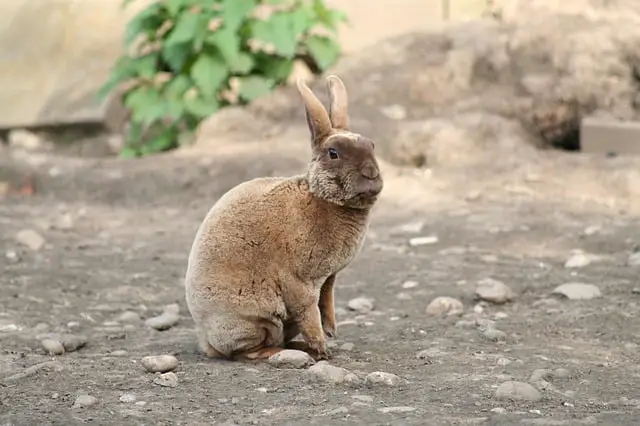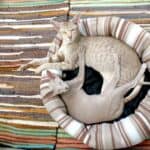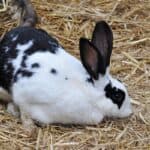
The Rex rabbit is considered one of the best rabbit breeds to be adopted as a pet, due to its great intelligence, affectionate and sociable character. They are perfect for living with children.
They are not a breed of rabbits that need special care, at least not very different from what we should provide to any other domestic rabbit.
In this post from Petlifey we will show you everything you need to know about the rex rabbit, such as its origins, characteristics, health, care … And much more! If you want to know more about the breed, don’t miss it, keep reading!
Origins of the Rex rabbit
The first appearances we have of the Rex rabbit are around 1920 in France (Louché-Pringé). It seems that the origin of this breed would be in a litter of wild gray rabbits, which suffered a mutation whereby their hair has a single coat at the same height, offering a velvety appearance and that has given them world fame.
Officially the breed was presented in 1924, during the celebration of the international rabbit show in Paris.
That same year it was presented in the United States by rabbit breeders John C. Fehr and Alfred Zimmerman. Shortly after, it was accepted by the American Rabbit Breedr’s Association ( ARBA ).
Their very special fur made millions of rabbits bred for years only and exclusively for how highly valued their skins were in the market.
Characteristics of the Rex breed rabbit
Within the morphological characteristics of the Rex rabbit, what is most striking is its fur, which is very soft (when you caress it it seems that you will touch velvet)
Rex are rabbits with a flat back and a very long and rounded body, with strongly muscled legs. The head is broad and sexually dimorphic, as the head of males is longer and more robust than that of females.
A specimen of rex rabbit usually weighs between 3 and 4.5 kilograms, the European variant being the smallest, which does not usually exceed 3.5 kilograms, while the American one is usually within the range of 3.5 – 4.5 kilos. In all cases, the rex is considered to be one of the large rabbit breeds.
The fur of the rex rabbit is short, smooth and with an average size of 1.25 centimeters. To top off its plush aesthetic, it features curly mustaches.
Regarding the color of their hair, a total of 17 colors and patterns are accepted, among which are included cinnamon, white, red, blue, mottled, mottled, stained … There is an immense variety of combinations between colors and patterns
- White: white fur and red or dull eyes
- Himalayan: white with dark ears and nose and red eyes
- Tortoise: fur with a tortoise-like pattern within a range of brown colors
- Chinchilla: grayish and homogeneous
- Blue: ash blue
- Seal: deep brown
- Opal: gray with light finishes
- Lynx: fur similar to that of a lynx
- Chocolate: different shades of chocolate
- Red: with coats between reddish and orange
- Broken: white base with spots of other colors
- Lilac: the most common variety of rex rabbits, with a dark purple, gray or brown hue
- Black: total and glossy black
What is the Character of the Rex rabbit?
Rex rabbits are very affectionate, that is why they are perfect for children. They like to be with their owners, they are really cuddly and are looking forward to being played with them.
Along with the particular fur of these rabbits, what most distinguishes them from other breeds is their friendly and affectionate character.
The maternal instinct of the breed, we find many cases in which rex rabbits have come to take under their care rabbits of other breeds or even other animals. In addition, with patience you can teach them some tricks, since they are a very intelligent breed of rabbits and they remain attentive, if we know how to motivate them.
Special care for the rex breed
The care that Rex rabbits need does not differ from what we must provide to any other rabbit.
Given the characteristics of the fur of these rabbits, which is quite delicate, we should not brush them very frequently, brushing at most once a week.
The cage:
Providing a large enough rabbit cage or house for our rex rabbit is essential for its well-being. The approximate dimensions of this cage, for one or two rabbits, can be 1.20 or 1.50 meters long by about 60 centimeters wide. Also, it should be tall so that you can stretch out your big ears.
The floor of the cage should not be made of wire, since it causes discomfort in the legs. On the other hand, it is advisable to cover this soil with a straw bed or similar. They will also need you to put up a house or hiding place inside to be able to feel safe and sleep peacefully. Another necessary accessory for your house is a litter box or corner to fulfill your needs.
What do Rex rabbits eat?
Rex rabbits need, like all rabbits, to have clean and fresh water at their disposal at all times, along with a large quantity of hay. Their diet must be supplemented with quality feed and fresh food.
How much does a Rex rabbit cost?
You can buy Rex rabbits in specialized stores or specialized breeders.
My recommendation is that if you can buy it from a breeder. Rex rabbit prices vary depending on where you buy it.
Common Diseases in the Rex Breed
Rex rabbits may have a tendency to develop some pathologies, one of them is the development of sores or wounds when their legs are in contact with hard surfaces for a long time, such as the metal bars of the cages, since their extremities do not have, as if they have other breeds of rabbits, with enough hair to act as a barrier.
Like the rest of rabbits, the rex is sensitive to cold and especially to drafts and humidity, so although we have to keep them in a well-ventilated place, especially in summer, when the low temperatures arrive we have to check that the space in which our rex lives is at a comfortable temperature and is not cold. Otherwise you could develop diseases like pneumonia.
We recommend that you take your rex rabbit to the vet at least twice a year and that your vaccinations are up-to-date.
In addition, you should go to the vet if your rex rabbit has symptoms such as:
- Excessive coat loss
- Lack of bowel movements in your litter box
- Does not jump or does not use its hind legs
- Dark-colored urine or lack of urine
- Tiredness and / or apathy
- Temperature of 40ºC or more
- Watery and / or runny eyes






